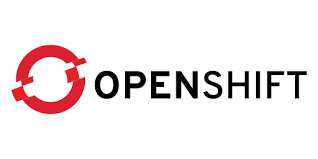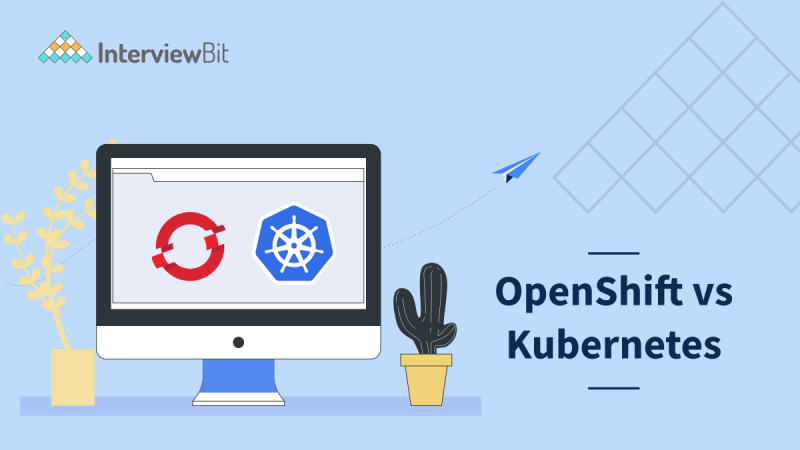- Introduction
- What is OpenShift?
- What is Kubernetes?
- OpenShift Vs Kubernetes: Differences and Comparison
- Conclusion
- Frequently Asked Questions
- 1. Is OpenShift certified Kubernetes?
- 2. What are the benefits of OpenShift over Kubernetes?
- 3. Is OpenShift difficult to learn?
- 4. What framework was used to develop OpenShift?
- 5. Which is better- OpenShift or Kubernetes?
- 6. Does OpenShift use Kubernetes?
- Important Resources
Introduction
Containers are a type of virtualization for operating systems. From a small microservice or software process to a huge application, a single container can operate it all. All the necessary executables, binary code, libraries, and configuration files are contained within a container. Containers, in contrast to the server or machine virtualization, do not contain operating system images. As a result, they are more lightweight and portable, with less overhead.
Two of the most well-known container development platforms are Kubernetes and OpenShift. When discussing OpenShift vs Kubernetes, you may hear the term “containerization.” But have you ever considered what it implies and how it is employed? Containerization is “the packaging of distinct applications to more effectively create, manage, and deploy them across numerous infrastructures,” according to a popular definition. Containerization allows businesses to be more flexible and scalable. As a result, application development is more efficient. Companies are increasingly recognizing the benefits of these tools.
Comparing Kubernetes to OpenShift can be confusing because Kubernetes is a core component of OpenShift. The vendor, Red Hat, refers to OpenShift as the “Enterprise Edition of Kubernetes.” There aren’t many containerization orchestrations to choose from, but picking the suitable one from among the finest is a difficult task. While Kubernetes automates app deployment, scaling, and operations, OpenShift helps apps run more efficiently by integrating with Kubernetes. This article compares and contrasts the most important features of OpenShift with Kubernetes.
Confused about your next job?
What is OpenShift?

OpenShift is a cloud development platform as a Service (PaaS) developed by Red Hat. It’s really useful for creating cloud-based applications. Red Hat’s OpenShift is a PaaS (platform as a service) cloud development platform. It’s a user-friendly open-source cloud-based platform for developing, testing, and running applications before deploying them to the cloud. OpenShift allows developers to use an integrated development environment (IDE) to create and deploy Docker-formatted containers, which are then managed by the Kubernetes platform. OpenShift can handle Node.js, Ruby, Python, Perl, and Java-based applications. OpenShift’s extensibility (It is extensible to new frameworks like Istio and Knative) is one of its most significant aspects, as it allows users to support applications built in various languages. Containerized apps can be scaled automatically or manually using the platform. As an abstraction layer, OpenShift includes several virtualization ideas. Virtualization is the main concept behind OpenShift (virtualization can be defined as the construction of a virtual system rather than a physical or actual replica of anything).
Key Features of OpenShift
- Cluster Installation – One of the new features in OpenShift 4 is cluster installation. OpenShift 4 includes an installer-provisioned architecture that gives installers complete control over the AWS installation process. This functionality allows clusters to be set up from scratch in minutes.
- Cluster upgrades – OpenShift’s update service has a simple UI that allows administrators to keep track of available updates of the clusters.
- Cloud Automation – Automation providers for virtual platforms such as OpenStack, VMware, and Red Hat Virtualization, as well as on-premises bare metals, are available in OpenShift 4.
- Knative – Knative, one of the new technologies in OpenShift 4, is suitable for creating Function-as-a-Service (FaaS) workloads. This feature primarily aids in the management, development, and deployment of a serverless workload that is scalable to meet specific demands and can scale down to zero when not in use.
- Kubernetes’ operators – Operators are one of the new OpenShift features that aid in the management of applications. It allows the code to interact with the Kubernetes system, which makes the job more dynamic and efficient. A Kubernetes operator’s tasks can range from growing a complicated app to upgrading application versions to maintaining kernel modules for nodes in a computing cluster with specialized hardware.
- ODO Command Line Interface – OpenShift 4 also includes ODO, a command-line interface (CLI). This Red Hat-developed CLI is great for optimizing code containerization and deployment on OpenShift.
What is Kubernetes?

More than a decade ago, Google developers created Kubernetes, an open-source container-as-a-service (CaaS) technology. Kubernetes is an open-source, portable containerization solution that allows developers to automate the deployment, management, scaling, and networking of containers. It assists in the enormous scale management of distributed, containerized applications. You tell Kubernetes where you want your software to run, and the platform handles practically all of the deployment and management for you. Kubernetes, which is now part of the Cloud Native Computing Foundation, allows application developers to take advantage of features such as self-monitoring, process automation, container balancing, storage orchestration, and more. For simple management and discovery, Kubernetes organizes containers into logical clusters. Kubernetes is capable of running in both cloud and on-premise systems, as well as hybrid clouds.
Key Features of Kubernetes
- Service Discovery and Load Balancing: Service discovery and load balancing are provided as services in Kubernetes. Kubernetes assigns DNS names, IP addresses, and load balances to pods (Pods are the smallest deployable units of computing that you can create and manage in Kubernetes) automatically. The Kubernetes Service collaborates with a set of pods to achieve load balancing. This serves as a central point for service discovery and allows access to the external network as well as access amongst pods through the same address.
- Automatic Bin Packing: Ensures resource availability and optimization by positioning containers according to their resource needs.
- Self-Recovery: Kubernetes (K8) restarts failing containers, replaces containers following node failures, and deletes containers that fail health checks.
- Rollout and Rollback Automation: When faults arise, the system is rolled back to a previous version, preventing system failure.
- Batch Execution and Scaling: This allows you to manually or automatically scale programs, as well as manage batches and Continuous Integration (CI) workloads.
- Replication Controller: A Replication Controller ensures that a specified number of pod replicas are running at any one time. To put it in simple words, a Replication Controller ensures that a pod or a set of pods is always up and available. The Replication Controller terminates excess pods if there are too many. It initiates extra pods if there aren’t enough. Replication Controller-managed pods, unlike manually produced pods, are automatically replaced if they fail, are deleted, or are terminated.
OpenShift Vs Kubernetes: Differences and Comparison

Now that we have some basic knowledge about OpenShift and Kubernetes, we will look at some of the differences between these platforms. Differences between OpenShift and Kubernetes have been provided below in a table format for side-by-side comparison.
| OpenShift | Kubernetes |
|---|---|
| OpenShift is not open-source. It is a commercial product. | Kubernetes is an open-source product. |
| OpenShift has stronger security policies than Kubernetes. OpenShift comes with an integrated service that makes authentication and authorization a simple process. | The Security policies of Kubernetes are somewhat lenient. Kubernetes lacks built-in capabilities for authentication and authorization. |
| There is a login page for OpenShift’s web console. The console is easily accessible, and most resources may be created or changed via a form. Servers, projects, and cluster roles may all be shown. | The Kubernetes dashboard must be installed separately, and you must use Kube-proxy to forward a port from your local workstation to the cluster’s admin server. |
| Scaling is simple by using OpenShift. | The addition of virtual machines in Kubernetes takes a long time. It necessitates the creation of YAML scripts by developers. |
| To manage the cluster, Red Hat OpenShift offers a user-friendly dashboard. | Kubernetes also provides a default dashboard to administer the cluster. However, because of its restricted functionality and minimal user interface, when the cluster increases in size, you’ll need to add more powerful tools like Istio, Prometheus, and Grafana. |
| The DeploymentConfig command is used to deploy OpenShift. DeploymentConfig, unlike Kubernetes objects, does not support multiple updates. | Deployment objects are used in Kubernetes deployment. Multiple and concurrent changes are supported by Kubernetes deployment objects. |
| OpenShift includes a built-in image registry that may be used with Red Hat or Docker Hub. | You can set up your own Docker registry with Kubernetes, however, there is no integrated image registry. |
| To upgrade OpenShift to the latest version, you must use the Red Hat Enterprise Linux package management system. | On both platforms, instead of rebuilding Kubernetes clusters from the ground up, you can upgrade existing clusters. |
| Red Hat’s proprietary Red Hat Enterprise Linux Atomic Host (RHELAH), Fedora, or CentOS is required for OpenShift. | As an open-source framework, Kubernetes provides more freedom, as it can be installed on practically any platform, including Microsoft Azure and AWS, as well as any Linux distribution, including Ubuntu and Debian. |
| OpenShift’s community support is limited primarily to Red Hat developers. | Kubernetes has a vibrant developer community that is constantly working to improve the platform. |
| OpenShift has an average of 3 updates per year. OpenShift DeploymentConfig does not support multiple concurrent updates | Kubernetes has an average of 4 updates per year. It supports multiple concurrent updates at the same time. |
| OpenShift features an out-of-the-box networking solution called Open vSwitch, which includes three native plug-ins. | Kubernetes does not include a networking solution, although it does let users utilize third-party network plug-ins. |
| The templates in OpenShift aren’t nearly as adaptable or user-friendly. | Kubernetes provides Helm templates that are simple to use and allow a lot of flexibility |
| OpenShift comes with its own image repository and works well with DockerHub and Red Hat. As a result, developers can use image streams to find and manage container images with ease. | Although Kubernetes lacks an integrated Image registry, it does allow you to pull images from a private registry to create your own pods. |
| OpenShift allows developers to use Image Streams to manage container images. | Kubernetes lacks container image management functionality |
| Although OpenShift does not provide a full CI/CD (continuous integration and continuous delivery) solution, it does include a Jenkins container that serves as a Continuous Integration server. | Kubernetes does not have a complete CI/CD (continuous integration and continuous delivery) solution, but by combining Kubernetes with technologies like automated monitoring, testing, and CI servers, you can build a comprehensive CI/CD pipeline. |
| It offers native networking solutions to users. | Some Kubernetes components don’t have networking solutions and offer third-party plugins. |
| Router objects provide external access to the OpenShift. | Ingress objects allow external access to the Kubernetes services. |
Conclusion
So, what should you use? Kubernetes and OpenShift are popular container management systems, and each has its own set of capabilities, advantages, and disadvantages. While K8s aids in the automation of application deployment, scaling, and operations, OpenShift is a containerization platform that works with Kubernetes to improve application performance. If you’re already familiar with containerization ideas and have some knowledge of K8s, you could prefer Kubernetes to OpenShift because it’s more flexible. OpenShift makes things easier for newbies by providing a better CLI and, of course, a web interface. Beginners should use the web interface rather than the command-line interface. The dashboard with K8s, on the other hand, isn’t ideal because it doesn’t add any more value to K8s than the command line. It totally depends on you what you chose, but I hope that this article has helped you in some way in selecting the best considering your needs and requirements.
Frequently Asked Questions
1. Is OpenShift certified Kubernetes?
Ans: Yes, OpenShift is certified by Kubernetes. It has been 100% certified by CNCF (Cloud Native Computing Foundation).
2. What are the benefits of OpenShift over Kubernetes?
Ans: OpenShift offers some benefits over Kubernetes. These are as follows-
- It provides a better User Interface.
- It provides Automated Workflow
- Continuous Integration/Continuous Delivery (CI/CD) Solution is effective in OpenShift.
- Security tools in OpenShift are better than in Kubernetes.
- Node Configuration is also great.
- Operating System Support
3. Is OpenShift difficult to learn?
Ans: No, OpenShift is not difficult to learn. It is beginner-friendly.
4. What framework was used to develop OpenShift?
Ans: OpenShift was developed by Red Hat and is written in Go, and Angular.js.
5. Which is better- OpenShift or Kubernetes?
Ans: OpenShift and Kubernetes are both popular container management systems that both have unique features and advantages that set them apart from each other. As Kubernetes automates application deployments, scaling, and operations, OpenShift helps applications run more efficiently by working with Kubernetes.
6. Does OpenShift use Kubernetes?
Ans: No. OpenShift and Kubernetes are different container orchestration platforms. OpenShift has a built-in Kubernetes platform, which makes the installation process easier, but is limited to Red Hat Linux distributions.







 Join WhatsApp Group
Join WhatsApp Group


